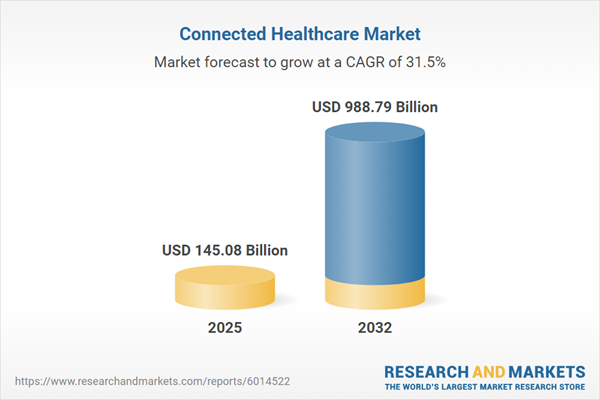Speak directly to the analyst to clarify any post sales queries you may have.
The connected healthcare market is transforming how organizations deliver care, enabling improved efficiency, secure digital integration, and agile responses to operational and regulatory demands. As healthcare systems undergo digital transformation, senior decision-makers need insights and strategies to align technology with growth objectives and compliance expectations.
Market Snapshot: Connected Healthcare Market Growth and Opportunities
The connected healthcare market is experiencing steady year-over-year growth, with projections of strong expansion into the coming decade. This advancement is powered by heightened investment in digital platforms, interoperable devices, and integrated therapeutic solutions. Organizations are increasingly using real-time digital tools to elevate both clinical and administrative functions, fostering agile decision-making and operational efficiency. C-suite leaders recognize digital transformation as pivotal for sustaining competitiveness, ensuring flexibility amid swift technology shifts, and adapting to regulatory requirements in a dynamic environment.
Scope & Segmentation: In-Depth Connected Healthcare Market Analysis
This report delivers actionable insights tailored for senior leadership, helping to identify opportunities and prioritize strategic initiatives across the digital healthcare ecosystem. The segmentation addresses market drivers and relevant areas in the evolving landscape:
- Component: Encompasses core hardware including diagnostic and wearable devices, as well as digital services such as consulting, system integration, and specialized software. These elements underpin data analytics, support clinical informatics, and drive deeper health data insights.
- Application: Spans chronic disease management, mobile health initiatives, remote patient monitoring, and telehealth solutions. Each application fosters prolonged patient engagement, supports tailored interventions, and enhances health outcomes through continuous oversight.
- End User: Includes ambulatory care centers, hospitals, clinics, home care organizations, and research institutions. Stakeholders across these sectors are adopting tailored digital solutions to optimize operational performance and elevate the quality of care delivery.
- Connectivity Technology: Considers the use of Bluetooth for device connections, cellular networks for reliable communications, and Wi-Fi for rapid data transmission. These technologies enable seamless provider collaboration and effective response across care environments.
- Deployment Model: Covers cloud, hybrid, and on-premises infrastructure options. Each deployment type supports organizational compliance, facilitates secure data management, and allows adaptability to region-specific regulations and operational needs.
- Regional Coverage: Reviews North America, Europe, Middle East & Africa, and Asia-Pacific. Analysis explores the diversity in digital maturity, legislative environments, and technology adoption patterns to support strategic, geographically relevant investment decisions.
- Company Insights: Offers benchmarking and partnership insights on leading organizations including Koninklijke Philips N.V., GE HealthCare Technologies Inc., Siemens Healthineers AG, Medtronic plc, Oracle Corporation, Teladoc Health, ResMed Inc., Allscripts Healthcare, IBM Corporation, and Cisco Systems.
Key Takeaways: Strategic Insights from the Connected Healthcare Market
- Integrated, cloud-based platforms combined with digital devices create transparency between clinical and back-office operations, supporting timely, informed leadership decisions across all levels.
- Wearable technologies and remote monitoring tools strengthen patient engagement, support proactive interventions, and enable continuous monitoring to enhance healthcare outcomes.
- Adopting open standards and interoperable IT ecosystems simplifies integration, streamlines data management, and helps organizations stay prepared for evolving compliance requirements.
- Collaboration between technology vendors, healthcare providers, payers, and device manufacturers drives the development of secure, privacy-first digital frameworks, underpinning the durability of healthcare delivery systems.
- Regional approaches anchored in local infrastructure and regulation foster innovation, optimize technology adoption, and enable organizations to respond effectively to unique geographic needs.
- Transitioning toward cloud and hybrid deployments ensures operational flexibility and organizational resilience in the face of regulatory and technological change.
Tariff Impact: Implications for Connected Healthcare Supply Chains
Recent U.S. tariff adjustments are increasing complexity throughout connected healthcare supply chains. As a result, manufacturers are diversifying sources and scaling domestic operations to offset added costs. Software providers are refining pricing strategies and enhancing fiscal monitoring through digital tools. In response to new risks, healthcare organizations are adopting cloud-based, compliance-focused solutions to protect sensitive data, ensure performance continuity, and safeguard data sovereignty amid industry-wide digital changes.
Methodology & Data Sources
The analysis draws on executive interviews and validated market benchmarks, complemented by comprehensive evaluation of digital healthcare adoption trends. Subject matter experts in healthcare and information technology verify findings to ensure alignment with current executive strategies and the evolving regulatory landscape.
Why This Report Matters for Senior Decision-Makers
- Enables senior leaders to strategically target investments, establish high-value alliances, and drive innovation within connected healthcare environments.
- Supports proactive risk management for operations and compliance, facilitating secure, adaptable supply chains.
- Delivers detailed segmentation and trend analysis for meaningful competitive differentiation and optimal results as digital transformation continues.
Conclusion
The connected healthcare market is accelerating digital convergence and organizational integration. This report equips decision-makers with actionable insights to navigate disruption, strengthen resilience, and lead transformation in healthcare delivery.
Additional Product Information:
- Purchase of this report includes 1 year online access with quarterly updates.
- This report can be updated on request. Please contact our Customer Experience team using the Ask a Question widget on our website.
Table of Contents
3. Executive Summary
4. Market Overview
7. Cumulative Impact of Artificial Intelligence 2025
Companies Mentioned
The companies profiled in this Connected Healthcare market report include:- Koninklijke Philips N.V.
- GE HealthCare Technologies Inc.
- Siemens Healthineers AG
- Medtronic plc
- Oracle Corporation
- Teladoc Health, Inc.
- ResMed Inc.
- Allscripts Healthcare, LLC
- IBM Corporation
- Cisco Systems, Inc.
Table Information
| Report Attribute | Details |
|---|---|
| No. of Pages | 192 |
| Published | October 2025 |
| Forecast Period | 2025 - 2032 |
| Estimated Market Value ( USD | $ 145.08 Billion |
| Forecasted Market Value ( USD | $ 988.79 Billion |
| Compound Annual Growth Rate | 31.5% |
| Regions Covered | Global |
| No. of Companies Mentioned | 11 |









